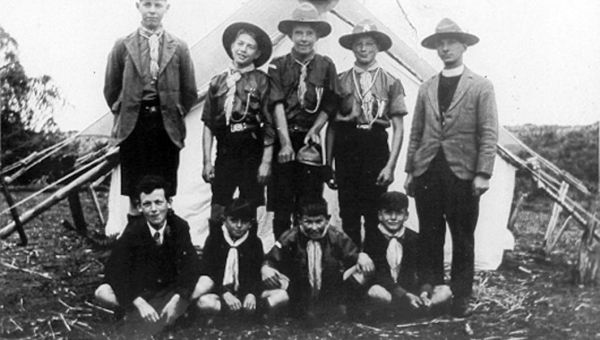 |
 |
|
Scouting
Scouting first appeared in Tasmania in 1909, within a year of the publication in Britain of Baden-Powell's Scouting for Boys. Small groups of boys in Hobart, Devonport and Wynyard, each supported by an enthusiastic adult, undertook challenging activities like 'ambulance work' and campcraft, where enjoyment and learning went hand in hand. When Baden-Powell first visited the state in 1912, similar groups of Scouts were functioning in other towns, a number meeting in Anglican church halls and receiving strong support from the clergy. Other Scout groups have had close ties with the YMCA, Toc H, Rotary and schools. A Council of Control of the League of Boy Scouts was set up as early as 1910, but registration certificates for new groups and authority for Leaders to act – there was no formal leader training prior to 1930 – still came from Imperial Headquarters in London. For the next fifty years senior British Scouting personnel came to the state to share ideas, offer advice and provide expert training for leaders. In earlier decades the movement in Tasmania received a modest, annual grant from the state government. This was supplemented by income from the Scout Shop and a waste materials collection service, while groups raised money from fairs, dances and euchre tournaments. Today the branch operates on a 'shoestring' budget, keeping expenditure low without reducing the functions and services it provides to Scouting. Wolf Cubs for younger boys began in 1916, sometimes led by senior Scouts but increasingly by Lady Cubmasters. By the mid-1920s when Sea Scouts made their first appearance, there were some 1000 Scouts of all ranks in the state; parent support groups began to appear; business, political and civic leaders were conspicuous in their support; and the organisation was confident enough to stage the first of six national Scouting youth events held in the state: a Scout Corroboree at Lake Sorell. Membership of Scouting and its distribution in Tasmania has always fluctuated, the availability of good leaders being the most decisive factor. It reached a peak of about 5000 in the early 1970s just prior to the introduction of major changes to the youth training programme. In 2004, it is about half that. From its humble beginnings here almost a century ago, Scouting's code of ethics and its commitment to the character development of young people through activities which foster self-confidence, self-reliance and leadership skills have remained unchanged. By contrast, the membership of the Movement, its programme, and its place in the life of the Tasmanian community have undergone major changes. From an organisation for pubescent boys in its first years, it has progressively extended the age range of its youth members from six years to 26, and it has welcomed girls into all sections. If Scouting is to continue to offer its joys and challenges to a wide cross-section of young Tasmanians, now more sophisticated, better educated and more demanding than ever before, then its greatest challenge is to attract, motivate and train enough committed leaders to influence the development of young people at a time when their enthusiasm, energy and ambition are boundless. Malcolm Grant |
Copyright 2006, Centre for Tasmanian Historical Studies |
